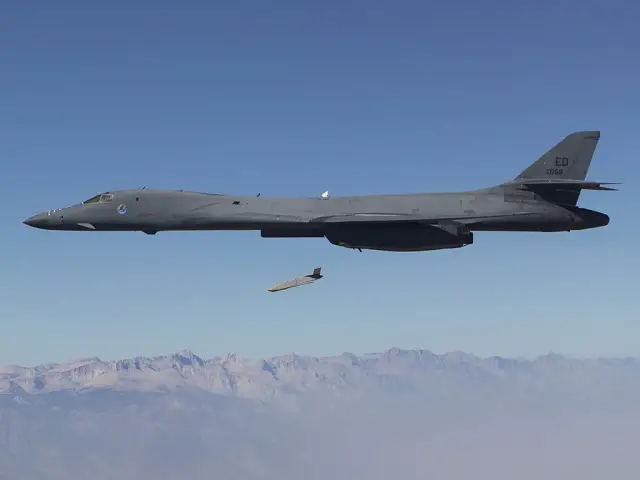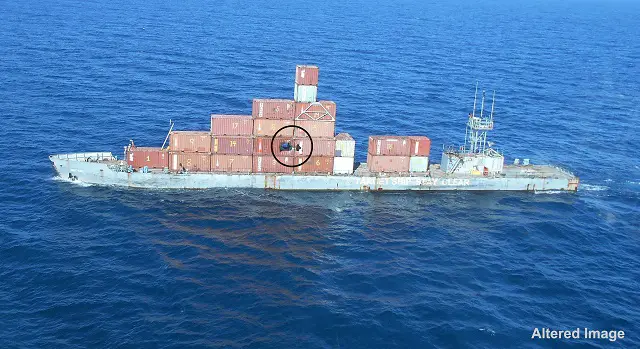|
|
| a |
Naval
Defense Industry News - USA |
| |
|
| |
| |
LRASM
Anti-Ship Missile Prototype Successfully Conducts First Solo Test Flight
|
| |
Adversaries’
sophisticated air defense systems can make it difficult for current
air- and surface-launched anti-ship missiles to hit their targets
at long range. To engage specific enemy warships from beyond the reach
of counter-fire systems, warfighters may require launching multiple
missiles or employing overhead targeting assets such as radar-equipped
planes or Global Positioning System (GPS) satellites—resources
that may not always be available.
|
|
 A B-1 bomber
from the 337th Test and Evaluation Squadron conducted the mission from
Dyess AFB, Tex., to the Point Mugu Sea Test Range off the coast of southern
California. Once in position, the B-1 released the LRASM
A B-1 bomber
from the 337th Test and Evaluation Squadron conducted the mission from
Dyess AFB, Tex., to the Point Mugu Sea Test Range off the coast of southern
California. Once in position, the B-1 released the LRASM |
|
Designed
for both surface and air launch,LRASM seeks to develop an autonomous,
precision-guided anti-ship standoff missile based on the successful
Joint Air to Surface Standoff Missile Extended Range (JASSM-ER) system.
LRASM aims to incorporate sensors and systems to create a stealthy and
survivable subsonic cruise missile with reduced dependence on intelligence,
surveillance and reconnaissance (ISR) platforms, network links and GPS
navigation in electronic warfare environments. The program also focuses
on precision lethality in the face of advanced countermeasures.
“This fully functional test is a significant step in providing
the U.S. Navy and U.S. Air Force with a next-generation anti-ship missile
capability,” said Artie Mabbett, DARPA program manager for LRASM.
“This test is the culmination of the five-year development and
integration of advanced sensors in an All-Up-Round (AUR) missile. It
also represents the first time we’ve integrated advanced sensors
and demonstrated the entire system, resulting in performance that substantially
exceeds our current capabilities.” |
|
 Approximately
halfway to its destination, the weapon switched to autonomous guidance,
in which it autonomously detected the moving MST and guided itself to
hit the desired location on the target. A F/A-18 fighter from the Air
Test and Evaluation Squadron (VX) 31 in China Lake, Calif., followed
the weapon during the flight.
Approximately
halfway to its destination, the weapon switched to autonomous guidance,
in which it autonomously detected the moving MST and guided itself to
hit the desired location on the target. A F/A-18 fighter from the Air
Test and Evaluation Squadron (VX) 31 in China Lake, Calif., followed
the weapon during the flight. |
|
DARPA
designed the free-flight transition test (FFTT) demonstration to verify
the missile’s flight characteristics and assess subsystem and
sensor performance. Beyond the primary objectives of the free-flight
transition, the test vehicle also detected, engaged and hit an unmanned
260-foot Mobile Ship Target (MST) with an inert warhead.
A B-1 bomber from the 337th Test and Evaluation Squadron conducted the
mission from Dyess AFB, Tex., to the Point Mugu Sea Test Range off the
coast of southern California. Once in position, the B-1 released the
LRASM, which followed a pre-planned route towards the target. Approximately
halfway to its destination, the weapon switched to autonomous guidance,
in which it autonomously detected the moving MST and guided itself to
hit the desired location on the target. A F/A-18 fighter from the Air
Test and Evaluation Squadron (VX) 31 in China Lake, Calif., followed
the weapon during the flight.
Lockheed Martin Missiles and Fire Control (LMMFC) is the prime contractor
for the demonstration of the LRASM weapon. BAE Systems’ Information
and Electronic Systems Integration division is the prime contractor
for the design and delivery of LRASM’s onboard sensor systems. |